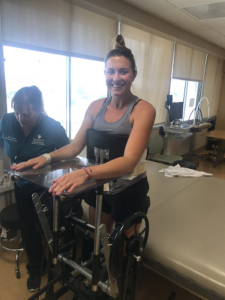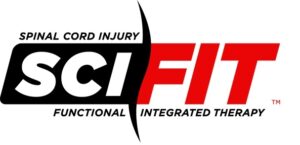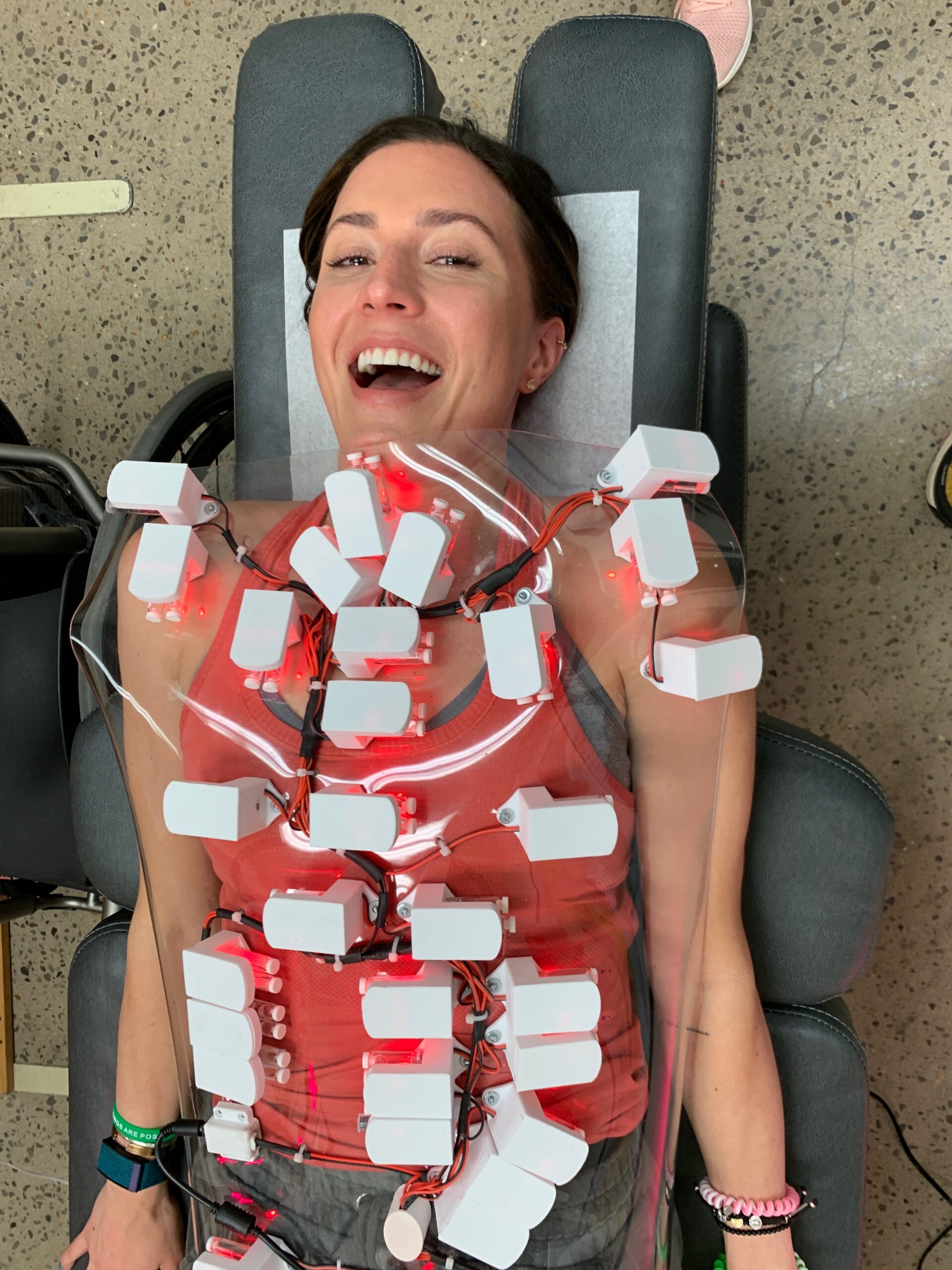Physical therapy can feel like such a burden, or at least that’s what survivors have told us. If it isn’t the worry that they’re completely unprepared, then it’s the feeling that they’re too weak, depressed, or even embarrassed to go. Still worse are those survivors forced to advocate for what they feel they truly need, only to be told “that’s not how we do things here” time and time again. One company hopes to change the way survivors feel about being physical and making progress after neurological injuries like brain aneurysms and AVMs. That shining light is SCI-FIT.
Pronounced “S” “C” “I” Fit and not like a shortcut for the word Science, SCI-FIT is an acronym for Spinal Cord Injury Functional Integrated Therapy and they specialize in nontraditional spinal cord injury rehabilitation. Their mission is to provide the most comprehensive, post-traditional, exercise based therapy for those individuals who have suffered a debilitating injury. SCI-FIT maximizes the potential for each individual suffering from spinal cord injuries and other neurological disorders by utilizing strategic exercises and providing the proper stimulation for an optimal functional outcome.
Ok, but where does this community fit in? Meet Taylor.

Wait. Actually, this may be the second or even third time you’ve met Taylor. In truth,
- Taylor introduced US to SCI-FIT...
- Taylor reminded us that we were the only ones helping folks like her, the only ones until SCI-FIT that is, and…
- Taylor chose TAAF even when TAAF was rarely helping someone with her circumstances. Why is that? What makes Taylor so different?
Taylor’s AVM wasn’t in her brain. TAYLOR’S AVM was in her spine!
Taylor: I’m technically a “T10-L3 incomplete paraplegic,” but I like to tell myself that “I’m recovering from a gnarly spinal surgery.” I woke up paralyzed from the waist down, with little to no feeling or movement following a 15.5 hour spinal AVM resection. A day prior to the resection, I underwent an angiogram in hopes of amending the AVM, but it was too far gone and required a complex neurovascular surgery that would include a laminectomy, cutting through my beloved spine’s dura and intricately removing the AVM that had grown into my spinal cord, as well as the front and backside of it. It was devastating, but my surgeon reassured me that I’d be walking in some 6-12 months. The surgery had to be performed, “I was a ticking time bomb” and no one knew the extent of damage that would happen, had the AVM hemorrhaged. My surgeon and anesthesiologist(s) had never seen an AVM (arteriovenous malformation) so complex. A spinal arteriovenous malformation is an abnormal tangle of blood vessels on, in, or near the spinal cord, or in my case both, in and on the spine.
What brought me to the doctor was what I believed to be sciatica. I thought I might have a slipped disk. Then after a while, I started having little spasms in my legs as well as bad balance with a dose of foot drop. Once I got my spine MRI back, it was plain as day. I had a huge spinal AVM that had likely been growing since I was in utero.
After nine foggy days in UCSF’s neuro ICU, I was shipped home to Fresno’s Leon S Peters rehab facility where I would reside for the next seventeen days. Those were some of the darkest days of my life. I couldn’t recognize myself. I was a shell of the person I was just nine short days earlier, both physically and emotionally. I got to know the feeling of real loneliness and real pain. It was no fault of any therapist or doctor, my husband or family; but going from strong and independent to completely dependent on someone else’s care is a heavy load to handle. I thank God for my Faith everyday. It has been the foundation in my healing journey.
TAAF: That was undoubtedly a lot for you to process, or anyone for that matter. What was your outlook on recovery? What was your doctor's/PT's outlook for you?
Taylor: Since day ONE, I’ve told myself that I will beat this. It's just a matter of time. Recovering from an injury like mine requires a ton of mental grit and patience. I will strive to reach my best physical and mental state that I can, bottom line. That is all I can do. My surgeon believed I’d be walking in 6-12 months. My PT didn’t know. And by the way, no PT will ever “know,” which is why I’m so passionate about finding the right PT. So many SCI (spinal cord injury) individuals give up on recovery based on what their physical therapists have told them. It's absolute malarkey.
TAAF: For the record, we love PTs and don’t think most are full of anything, except hope and those giant rubber bands. But seriously, we hear you. The idea that anyone, PT or otherwise, can define your potential is indeed malark… er, challenging.
This must be where your search began. How did you hear about SCI-FIT? And when did you first join the program? How long after your injury did you begin?
Taylor: I was SO hungry to get started in PT. I can remember reaching out to a friend who had a brother that had gone to SCI-FIT after his initial injury. They recommended SCI-FIT to me. I was maybe two weeks out of surgery and ready to hit the ground running, though I really only had one quad that was firing. I was one of SCI-FIT Fresno’s first clients. It was six months post surgery that I started attending twice a week.
TAAF: SCI-FIT’s first goal was to create an opportunity for individuals with spinal cord injuries to participate in an aggressive therapy program. What were you hoping to get out of their program? Did you have short term and long term goals?
Taylor: I was hoping to get myself back. I’ve known that I will never be the old Tay that I once was, but I will strive to be closest to what I once was. This keeps me hungry to progress, but it also keeps me mentally strong, which is a HUGE part of success in this recovery. My long term goal has been and will always be to walk independently. To be able to bend down and pick something up off the ground by myself. The short term goals change frequently as I progress.
TAAF: You’ve done traditional PT and found it lacking. What are your favorite aspects of your program at SCI-FIT?
Taylor: You actually feel like you’re an athlete when you’re in the SCI-FIT gym, rather than in a geriatric rehab center.
TAAF: Uh, we’ve seen some of your SCI-FIT videos, and we’re pretty sure you and your gym buds may secretly be in the WWE. Wow! Those are some tough workouts. Can you share one goal that you have reached and what reaching that goal meant to you.
Taylor: Walking up stairs, walking in the pool and riding my tricycle. It means FREEDOM.
TAAF: It sounds like your life has really changed after beginning SCI-FIT.
Taylor: I truly love the team at SCI-FIT Fresno. NO ONE brings any personal issues to the gym. It's professional, compassionate, engaging and a seriously good workout. I’m truly grateful for the team. There hasn’t been a day that I haven’t wanted to show up for a workout... and that says it all!
It does say it all, well almost! We want to share that this year our admiration for SCI-FIT’s service to the community has come full circle and we’re delighted to welcome them to their first-ever TAAFWalk. Be sure to visit their booth to learn more about their mission and meet some new friends who are just as passionate about your recovery as you are.
To learn more about how SCI-FIT serves our community, click their logo below.


